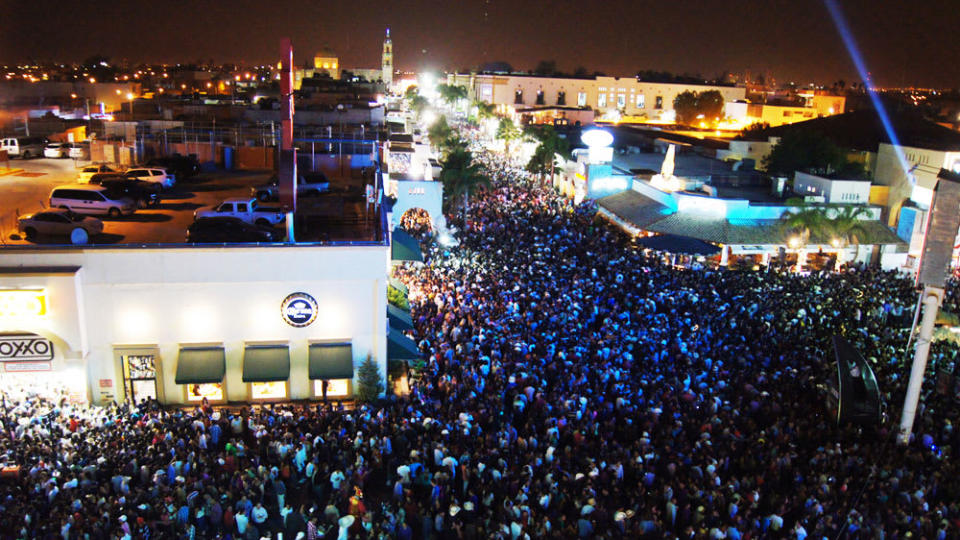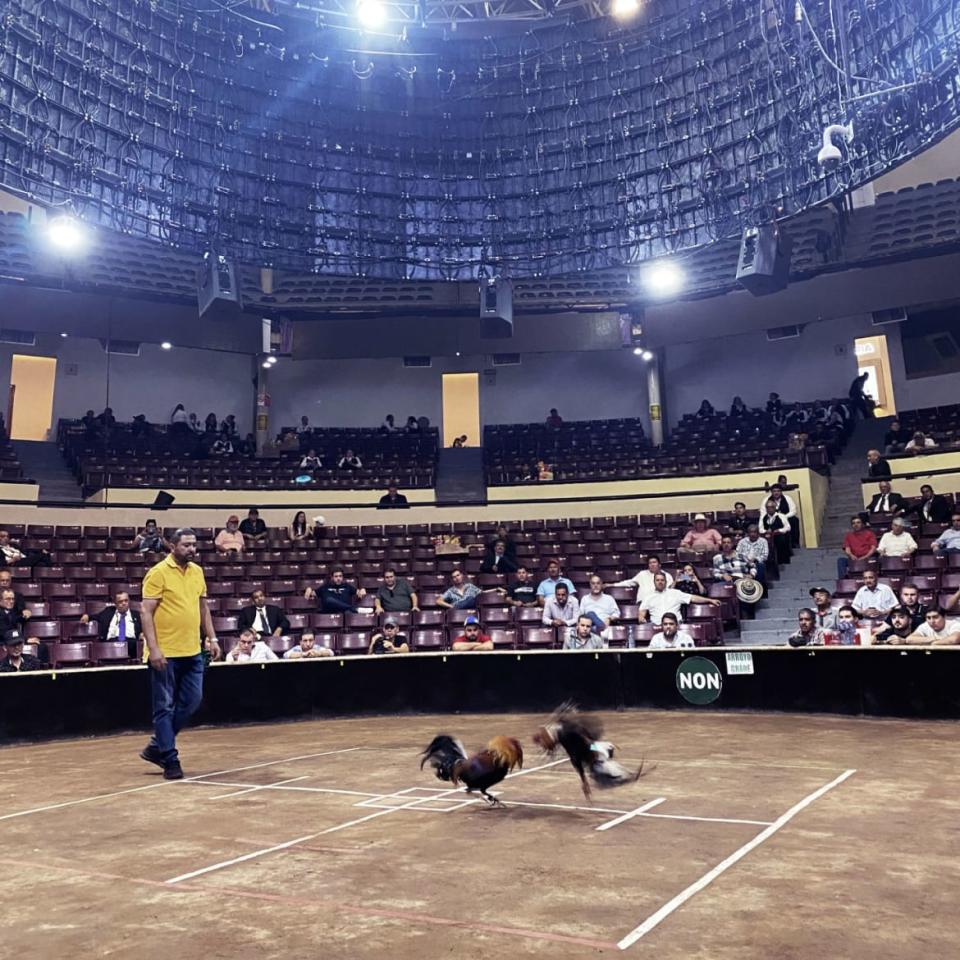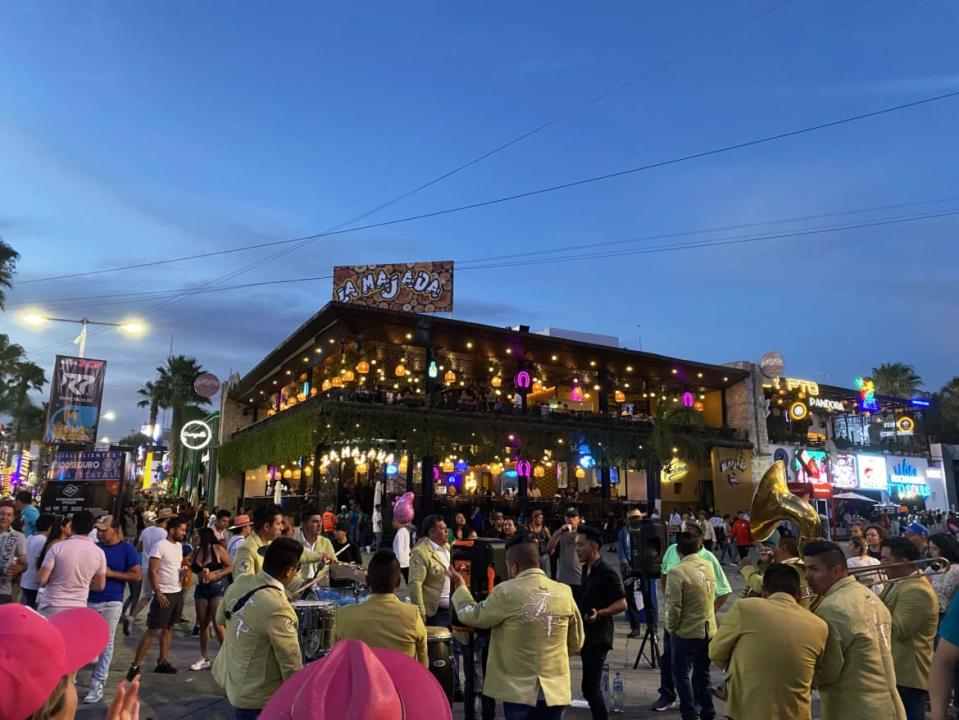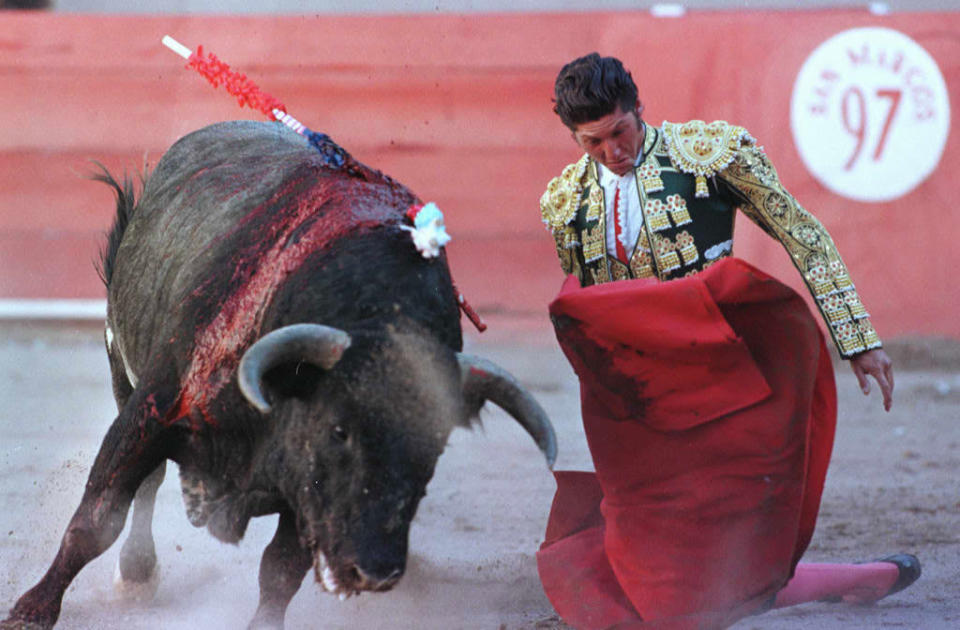The Mexican Carnival Pairing Cockfights and Latin Pop Stars

Before Christian Nodal, the tattooed prince of ranchera music, could take his place at the center of the palenque at the Feria de San Marcos earlier this year, the dirt arena had to be cleaned. A day’s worth of cockfights had left the site of the stage bloodied and strewn with feathers.
A warm-up act came next. Thousands of fans had descended upon the capital of the tiny Mexican state of Aguascalientes to see Nodal open the annual fair with the accordion-laced ballads that have propelled his genre to the top of the charts, and organizers wanted to keep pre-show energy high.
Speaking into a stick mic, an emcee solicited bids for a series of raffles that topped out at over $500 per entry. Gamblers placed their bets into cut-open tennis balls and tossed them back to a bookie.
If the backdrop for the headliner was unusual, he was at least in good company. For the next three weeks, a veritable constellation of Latin music stars would follow.
As Spanish-language music reaches new heights in the U.S., the Feria de San Marcos, a nearly 200-year-old agricultural festival, has emerged as an unlikely showcase. At this year’s edition, Maluma, Bizarrap, and Camilo were among the closing acts for a day of carnival pleasures, horse trading, and animal bloodsport.
“Even though it’s not in a major city,” said Luis González, an artist manager based in Mexico City, “when you talk with Latin artists about the Feria de San Marcos, they know where it is.”
“It’s the only fair like this that can attract such big artists,” he said.
Set over 200 acres of tinselly fairground, the Feria de San Marcos is like if a Ringling niece had a blowout quincea?era. Down wide promenades and hilly lawns, an army of merchants moves in, hawking stuffed tortillas and beers with unfathomable mix-ins. Big tops pop up to shade farm-fulls of animals. Midways extend into twinkling blurs.
From morning to well past midnight, a playlist of Latin music best of sets the fair in rhythm. An industry term for songs sung in Spanish and Portuguese, the genre spans continents and generations, pulling from a times table of meters and different regional styles.
At the fair’s central crossing, 12-man ensembles play banda, a Mexican polka, in matching sequined suits. In the Zona de Antros, a stretch of side-by-side nightclubs, crowds mosh outside to the chucu-chu of cumbia.
Two stages host the main draws: the palenque, a traditional venue found at backcountry fairs like this across the country, and the Foro de Las Estrellas, a more modern setting where the entrance is free. The A-list artists who perform there are sponsored by a combination of funds from the government and local benefactors.
When Maluma, the Colombian reggaeton idol, played the public stage on a recent Monday—his first concert since the Qatar World Cup—32,000 fans poured in before capacity was reached. An estimated 8,000 more watched from outside, screaming lyrics at a livestream and joining chants of “take your shirt off!” (He did at the end of the show.)
“There were people that lined up for two days to get in,” said Ray Macías, a local radio host. “Maluma’s songs are extremely popular and they’re all hits so people were singing the whole time.”

Heavyweights from the Latin world like Maluma and Bizarrap, the Argentinian DJ whose Shakira-led diss track broke YouTube records when it was released in the spring, have built the genre an outsized following in the U.S. According to a March report from Luminate, which tracks data across the entertainment industry, 24 percent of music listeners in the US are playing songs in Spanish—more than the share of Spanish speakers in the country.
Follow the Billboard Hot 100, which charts the most popular songs in the U.S. across all genres, and an even more surprising trend jumps out: Americans are obsessed with Regional Mexican music, a catchall for the twangy folk songs from the country’s rural reaches.
In 2021, Nodal, the Feria de San Marcos opener, and Mexican rapper Gera MX charted the first-ever Regional Mexican song on the Hot 100 with “Botella Tras Botella,” a country crossover about drinking to forget an ex with the pacing of a funeral march. Earlier this summer, there were 12 Regional Mexican tracks on the list, driven by a new class of boundary-blurring talent.
"You have a chart that measures the performance of all the songs in this country — country and hip hop and everybody—and then you have some Regional Mexican song with accordions and tubas," said Leila Cobo, the chief content officer for Latin at Billboard and the author of Decoding ‘Despacito’: An Oral History of Latin Music.
"Like in the same tier as Miley Cyrus, really? It’s a big deal,” she said.
The earliest version of the Feria de San Marcos, held in 1828, would have been a distinctly less trendy affair. Back then, the stars of the show were cows.
The commercial fair that year, held off the city’s main square in the chill of November, was part of a network of exchanges for regional goods expanding across Mexican territory. Aguascalientes, a breadbasket for the nearby mining center of Zacatecas, could share the tools for fueling a hardhat population: cattle and grain.
Chroniclers mark the fair’s evolution from there with several milestones: 1848, when officials moved its location and date, to April, with its more welcoming 80-degree average; the construction of the bull ring and casino, which established the event as an entertainment attraction; its 20th-century promotion from provincial to national fair.
According to Adrián Sánchez, an Aguascalientes historian, the fair’s first performers were local women who sang ranchera between the rounds of cockfights.

Soon, the fair became known for its swelling dance halls, with norte?o orchestras and the thick mustached big-names of the day traveling in to play live. In the late 1990s, in a bid to boost attendance, the local government began paying for blockbuster acts, like a show by Joan Manuel Serrat, the Spanish singer, that a Mexico City newspaper billed as “one of the most important mass gatherings of the season.”
This year, there were nearly 10 million visits to the Feria de San Marcos, organizers said, making it the most popular fair in Latin America. In Aguascalientes, the sixth-smallest Mexican state, it makes more money in its three-week run than all but what two companies pull in year-round.
In this deeply religious country, it’s even more important than Jesus: standard Holy Week closures in the run-up to Easter are postponed in the city so that locals’ time off lands during the fair’s length.
“I’m happy to be here even though it’s Tuesday,” Pepe Aguilar, one of the legends of the Regional Mexican old guard performing at the palenque, told reporters ahead of his sold-out show in April. “It’s even more special because it’s just locals.”
Put aside the celebrities, however, and the fair is still very much about animals—selling them, riding them, roping them, fighting them, and making them fight each other.
To buy a cow today, take a short shuttle ride from the main fairground to the Isla San Marcos, a rolling green space with expos, thrill rides, and enough livestock to supply a chain of Costcos. For the more casual consumer, leather byproducts are also for sale: smooth, sturdy sombreros, in the full spectrum of brown, run around 600 pesos, or $30.
Cowboy style is on full display at a Mexican rodeo, or charreada, held in the new Arena San Marcos, a towering stadium of clay-colored steel and wraparound glass.

As a live mariachi band plays on a side stage, the country’s best squads compete each day of the fair in a series of escalating ranch tricks, deploying tight ropework and grappling maneuvers down a 60-meter straightaway. In one event, piales, the charro sits horseback and aims his lasso at the hind legs of a fast fleeing mare, a puff of smoke bursting from his lap as the rope burns against the saddlehorn.
Of all the animal games at the Feria de San Marcos, the charreada may be the most humane—in the end, the animals survive. Back at the main fairground, flocks of roosters are downed by the hour in the palenque’s dusty pit.
There’s not much human skill required in a cockfight, like the dexterity on display in a charreada, and no pageantry, in which the bullfights at the fair’s Plaza de Toros find some redemption.

In a match, handlers strap razor blades to the talons of two birds and rile them up before sending them off into a chalk-painted grid. It’s the animal’s instinct to fight—a rush of red, gold, and green, claws flailing, last one standing wins.
Fights, held every day of the fair, last up to 20 minutes, drawn out by the handlers, who blow liquor down the beaks of the dying birds to revive them, like a boost of nitrous before a car crash. In the crowd, regulars with nicknames like “Toro” swill brandy and pile up tickets that record their bets—red for one rooster, green for the other.
While activists have moved to ban the sport across the country, in Aguascalientes, cockfighting’s long history at the fair and ties to the state’s economy have centered it as a point of pride. Local law protects it as an element of cultural heritage.
Fans find a kind of artistry in the spectacle. “Someone who has seen many fights can observe things that most people don’t,” said Juan Francisco Ovalle, the former Aguascalientes delegate to the National Section of Fighting Birds, “the speed, the reflexes, the intelligence that the animals have in a fight.”
On a visit to the Feria de San Marcos in the 1950s, Chilean singer Juan S. Garrido was awed at a match, remembering the bird’s “shimmering feathers” and “razors glinting in the sun” in his song “Pelea de Gallos.”
Now played by roving trios that weave through tables at lunchtime and by a full string and brass band each night at the palenque, the mariachi classic has become a local anthem, with a refrain that compels shouting along: “Long live Aguascalientes, your fair is a beauty!”
Get the Daily Beast's biggest scoops and scandals delivered right to your inbox. Sign up now.
Stay informed and gain unlimited access to the Daily Beast's unmatched reporting. Subscribe now.